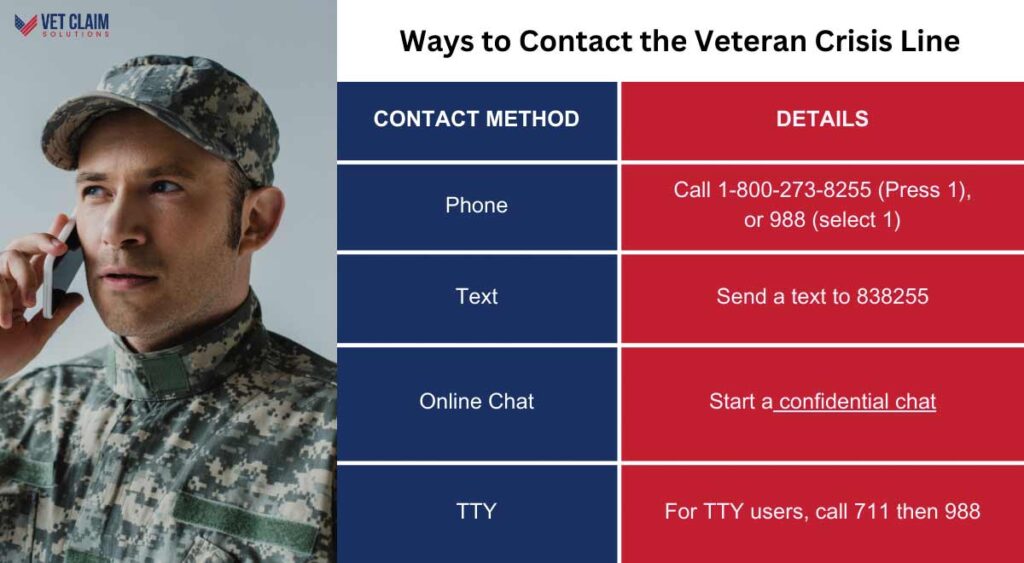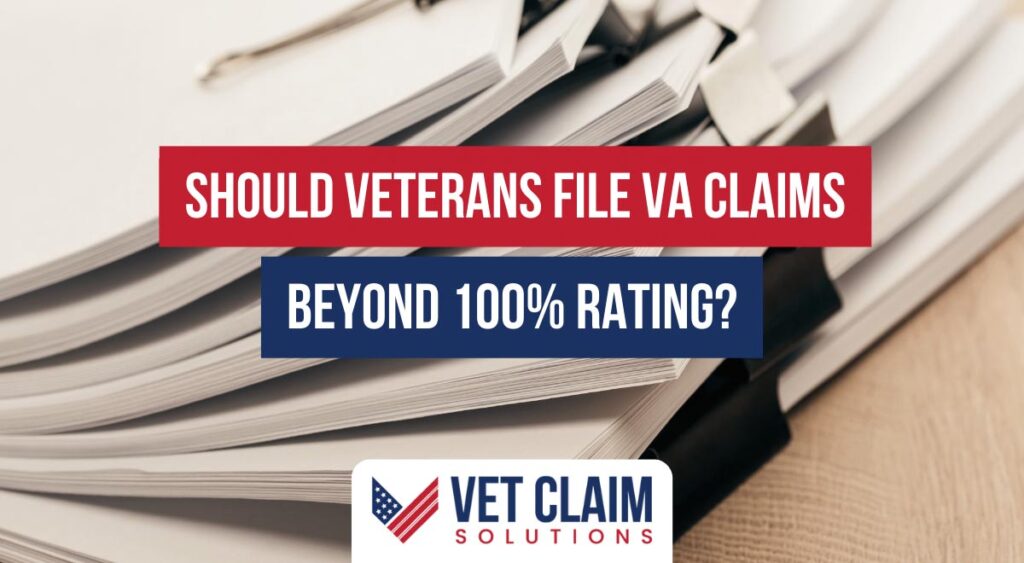You’re a veteran with a 100% disability rating from the Department of Veterans Affairs (VA). This means you are receiving the maximum schedular compensation. So, should veterans file a VA claim if their VA rating is already 100 percent?
It might seem counterintuitive, but there are situations where filing a new claim could lead to increased benefits. This is not always the case, but sometimes filing a new claim makes sense. This post addresses the question, “Should Veterans File a VA Claim If Their VA Rating Is Already 100 Percent?”.
Why Consider Filing Another VA Claim at 100%?
The VA assigns va disability ratings from 0 to 100 percent, utilizing the Schedule for Rating Disabilities (VASRD). A 100% rating indicates that a veteran’s service-connected conditions are considered totally disabling. This rating acknowledges the significant impact of the service-connected disability on the veteran’s life.
As of 2025, this provides $3,831.30 per month for a veteran with no dependents. This monthly compensation can help offset lost earning potential due to the disabilities. There are several compelling reasons to consider filing another claim, even at the 100% level.
Getting Compensation Above 100%
The VA offers Special Monthly Compensation (SMC) for certain severe disabilities. This includes the loss of use of limbs or sensory organs, or if a veteran is bedridden or requires daily assistance. SMC recognizes the extraordinary challenges faced by veterans with these severe conditions.
SMC rates are paid in *addition* to the standard disability compensation rates, further assisting with the profound impact of these disabilities. If your condition has worsened, exploring SMC could provide additional financial support. This could improve the quality of life for severely disabled veterans.
Qualifying for Specific VA Benefits
Some VA benefits are contingent upon the veteran’s specific conditions, such as the VA specially adapted housing grant. Another example of extra benefits includes the VA automotive adaptive equipment grant. These programs provide targeted support to meet specific needs.
You might need to file additional claims for a specific condition to access these additional benefits. This holds true even if you are already rated at 100%. Carefully consider all potential scenarios when making your decision about filing additional claims.

Protection Against Future Rating Reductions
The VA can propose va rating reductions if they determine a condition has improved. Having service connection for multiple disabilities provides a crucial safety net. This is a safety net for any changes to one condition in particular.
Even if one condition’s rating is reduced, others can help maintain the overall rating. Protecting against future reductions is a primary concern for many veterans. Maintaining a stable combined disability rating is vital for long-term financial security.
Transitioning from TDIU to Permanent and Total Status
Individual Unemployability, also known as TDIU, provides compensation at the 100% rate. This is for veterans who are unable to maintain substantially gainful employment due to their service-connected conditions, even if their combined disability rating is less than 100%. However, TDIU comes with certain restrictions, such as income limits.
Filing additional claims can help veterans transition from TDIU to a permanent and total disability rating. This transition removes certain restrictions and may provide access to additional benefits like educational benefits. This could create greater financial stability and open up new opportunities.
Common Types of Claims Filed at 100%
Veterans with a 100% va disability rating often consider a few options when it comes to additional claims. Common next steps include things such as, new claim, and secondary service connection claim.
- New Claims
- Secondary Service Connection
Knowing how and when to pursue these options is crucial for maximizing your chances of success. Properly structuring your claim improves your potential to get an increase in your benefits.

Filing a New Claim
To file a new claim as someone at the 100 percent level, you need proof of issues that are “new and relevant.” You will need to provide new evidence that the VA has not previously considered. Presenting fresh documentation or medical opinions strengthens your claim.
Filing for Secondary Service Connection
Often, veterans at the 100 percent level have been approved with multiple service-connected disabilities that combine to reach that rating. By exploring secondary service connections, you can potentially increase your overall rating and access additional benefits. Reading online blogs and other veterans claims resources can offer valuable insights into this process.
Should Veterans File a VA Claim If Their VA Rating Is Already 100 Percent?
A new claim could potentially lead to a better outcome in your claim for increased benefits. However, it also opens up your entire claim file for review by the VA. Weighing the potential benefits against the risks is important before the process is started.
The VA may review all of your service-connected conditions. This comprehensive review ensures compliance with regulations and prevents the same symptoms from being counted towards multiple disability claims. Careful consideration of all factors is very important when seeking the best solution for yourself.
Here are examples of specific disabilities that often prompt veterans with an existing 100% rating to consider filing additional VA claims:
- Gastritis: Veterans experiencing persistent digestive issues may have a VA rating for gastritis. If this condition worsens or leads to other complications, providing new and relevant evidence for reevaluation is crucial.
- Dysphagia: Difficulty swallowing, or dysphagia, can severely affect a veteran’s quality of life. Those with an existing rating should seek reassessment if their condition progresses.
- Pancreatitis: Chronic or recurrent pancreatitis can be debilitating. The situation warrants a review of the disability rating when symptoms persist or flare-ups become more frequent.

Remember, you will need up-to-date medical documentation and doctors’ records to support your claim. You may also need to undergo additional medical examinations. Be sure to prepare all relevant medical data that you want considered.
If the VA determines that a condition has improved, they have the authority to reduce the rating. Additionally, claims related to incidents like auto accidents or sports team injuries that occurred outside of service are unlikely to qualify for va disability benefit. These events are typically not considered service-connected.
Permanent and Total Status
Achieving permanent and total status can lead to significant differences in a veteran’s benefits. Once granted, this status often eliminates the need for future medical examinations. It simplifies the veteran’s interaction with the VA.
If the VA rates a veteran with a 100% schedular VA disability rating, the notification document may appear slightly different. However, the VA typically sends information explicitly stating that the total disability based on permanent status, indicating little to no chance of improvement. This status provides long-term stability and security.
Temporary 100% VA Disability Rating
Sometimes, individuals require time off from work due to conditions that are not expected to improve quickly. This situation is common among many veterans needing an extended amount of time. When veterans are unable to work for an extended period and need time off, they may be granted this classification.
For example, a veteran recovering from surgery at a medical center might be approved for a temporary 100% rating. The VA provides temporary total disability benefits for periods when individuals are not at their best. Prestabilization ratings can also be assigned immediately following discharge from service.
Increased Claims in the VA System
There has been a noticeable increase in veterans filing claims with multiple medical issues. Over the past decade, original claims involving eight or more contentions have risen by 200%. This highlights the growing complexity of va disability benefits claims.
Many of these claims originate from an aging veteran population and those experiencing long-term effects of service, such as exposure to burn pits or PTSD. Additionally, many older veterans decide to file claims upon retirement, contributing to the increase. Filing after retirement also factors into this equation.

Supplemental Claims Inventory Breakdown
It’s insightful to examine the current breakdown of supplemental claims within the VA system. This provides an additional layer of details to consider.
- Supplemental claims make up slightly under two-thirds of the pending claims, accounting for 63%.
- Approximately four-fifths of veterans filing claims are already receiving other monetary benefits.
- Around one in ten veterans have 100 percent va disability ratings.
- Just below half of all veterans with a disability are rated 50% disability or higher.
- Vietnam-era Veterans constitute slightly over one-third of all claimants.
Many older Veterans continue to pursue their claims for years, particularly when new claim information could support their case and potentially lead to a favorable outcome. The claims process can be challenging, and not everyone fully understands all aspects of it. Seeking advice before making critical decisions is often beneficial.
VA Form 21-526EZ: What Is It?
Veterans may find the process of navigating the VA system and securing the compensation they deserve to be overwhelming. Using the correct VA forms is an excellent starting point. Utilizing things properly helps streamline things.
VA Form 21-526EZ, Application for Disability Compensation and Related Compensation Benefits, is a crucial tool. Veterans should be prepared to file claims through various methods: online, in person at a VA office, or by mail. The VA has different routes a person can pursue things.
Remember to complete this form thoroughly and gather all relevant medical documentation to support your claim. By proactively collecting all necessary information, veterans can significantly improve their chances of success when pursuing increased claims. Proper medical documents strengthen your potential for benefits.

Conclusion
Should Veterans File a VA Claim If Their VA Rating Is Already 100 Percent? The answer is not always straightforward and varies depending on individual circumstances and many factors.
Seeking advice and exploring all available options could potentially result in years of additional benefits and care for those who have served our nation. If a veteran with a 100% rating experiences worsening conditions or new service-connected issues, filing a VA Claim might be a viable option to consider for your veteran’s condition.


